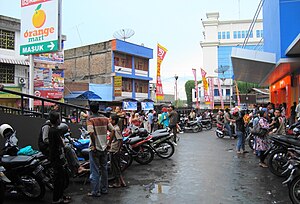Pematangsiantar
|
Pematangsiantar Kota Pematangsiantar |
||
|---|---|---|
| Other transcription(s) | ||
| • Chinese | 先達 | |
| • Hokkien | siàn ta̍t | |
 |
||
|
||
| Motto: Sapangambei Manoktok Hitei | ||
 Location of Pematangsiantar in Indonesia |
||
| Location of Pematangsiantar in Indonesia | ||
| Coordinates: 2°57′36″N 99°3′36″E / 2.96000°N 99.06000°E | ||
| Country | Indonesia | |
| Province | North Sumatra | |
| Government | ||
| • Mayor | Hulman Sitorus, SE | |
| Area | ||
| • Total | 79.97 km2 (30.88 sq mi) | |
| Population (2010) | ||
| • Total | 240,787 | |
| Time zone | WIB (UTC+7) | |
| Area code(s) | +62 622 | |
| Website | www |
|
Pematangsiantar (sometimes written as Pematang Siantar, acronym PS or P. Siantar, colloquially just Siantar), is an independent city in North Sumatra, Indonesia, surrounded by, but not part of, the Simalungun Regency. Pematangsiantar formerly had the status of a second level district (daerah tingkat dua) and has recently been elevated to Kota (City) - its population was 219,319 in the 1990 Census, 242,756 in the 2000 Census, and 240,787 in the 2010 Census, making it the second largest city in the province after the provincial capital Medan.
The city is divided administratively into eight districts (kecamatan), tabulated below with their 2010 Census population:
Before 1907, Pematangsiantar was a Kingdom led by the Damanik. Damanik is one of the clans of the Simalungun ethnic group of the Batak people. The last king of the dynasty was Tuan Sangnawaluh Damanik. In 1907, the Dutch took control, turning Pematangsiantar into their colony. The city remained under Dutch control until 1942 when the Japanese invaded and ruled over Indonesia.
After Indonesia proclaimed its freedom in 1945, Pematangsiantar was granted autonomous status. In 1974, Pematangsiantar became a second level district, and was appointed as the capital of Simalungun Regency.
Pematangsiantar's native inhabitants are the Simalungun Batak people, also the majority of the city. Today, Chinese are the largest minority along with ethnic Malays, and Javanese also inhabit some parts of the city, especially around the downtown area. The most developed part of the town is along the streets named Jalan Merdeka and Jalan Sutomo.
Pematangsiantar is 50 kilometres from Lake Toba on the Trans-Sumatran Highway. Lake Toba is one of the largest volcanic calderas in the world, and a major tourism destination. It is common to see tourists stopping over in Pt. Siantar. Siantar is famous for Batak culture, 'Batik' and 'Ulos' fabric, and Batak foods. There is a zoo worth visiting that is aptly named Taman Hewan Pematangsiantar - animal garden of Pematangsiantar (Kebun Binatang Pemetangsiantar in Indonesian). It has a good collection of Indonesian native animals, most notably birds, tigers and apes. The zoo itself boasts abundant tropical trees and plants, some of which are quite old. The location is close to the main roads of the city (within walking distance). Ticket price (April 2009) is 7,000 IDR. Another place of interest in the city is Vihara Avalokitesvara - a Buddhist Temple housing the Statue of Kwan Im. At 22.8 meter high, is the tallest statue of its kind in Indonesia. The temple complex is accessible from Jl. Pane. It is part of a new temple complex. Adjacent to the new complex and connected by a bridge across the river of Bah Bolon, the old building of the temple was burned completely in an inferno in May, 2008.
...
Wikipedia


